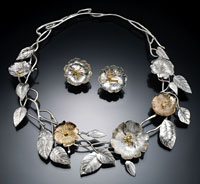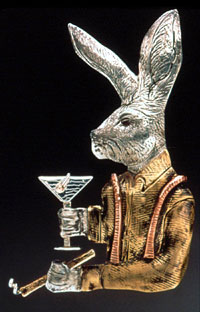Depicting Nature in Metal
 Copper accented necklace and earrings
Copper accented necklace and earringsPhotograph courtesy of Courtney Designs
Courtney Peterson stumbled upon the art of metal jewelry making when she and her sister opened an antique shop in New Orleans in the 1960's.
"There was a shop up the road where the guy was from England, and he was doing jewelry," she says. "So, my sister and I would play with materials. Because of things like copper and brass, you can start very inexpensively."
In fact, she recommends that kids with an interest in jewelry making begin with these metals.
"I say, 'Take yourself down to the hardware store, buy some brass and copper, and play around with it.' Starting with brass and copper, you don't feel as intimidated as you would if you're dealing with sterling or, God forbid, gold," she says.
Of course, now that she has more than 30 years of experience under her belt, Courtney works frequently with sterling and 14kt gold and often mixes metals. Most of her copper and brass come from Indian Jewelry Supply, while she gets silver from Academy Group and gold from Hoover & Strong.
The business, Courtney Design, really began when she met and married Lee Peterson, son of famed naturalist Roger Tory Peterson. Lee had written the Peterson Field Guide to Edible Wild Plants. So, the marriage was not just a romantic one - they married their talents as well and began a line of nature-based jewelry that is amazingly detailed. Their studio is located on a 200-year-old farm in southeastern Pennsylvania.
In the beginning, they focused primarily on the wholesale market and attended trade shows regularly in Atlanta, New York, and San Francisco. Today, they concentrate more on retail craft shows and custom work for such organizations as the Boston Museum of Art and The National Geographic Society.
 Copper accented rabbit
Copper accented rabbit Photograph by Courtney Designs
Courtney Design's catalog is astonishingly diverse. "It's really kind of silly," says Courtney. "Most people in a booth might have 25 pieces, 35 pieces of jewelry. But we are hard workers…. We really don't play the game right in terms of the art world - having 12 pieces and having each one cost $5,000 the way that most people do it." They have been criticized for displaying so many pieces at craft shows, but they like to try new things and have pieces that are inexpensive enough for a child to buy for their mothers.
This is not the only way that Courtney Design doesn't quite follow the rules of the game. "Years ago, I was in Mississippi at a rock and mineral show," Courtney says, "and these old guys in suspenders came up, and they were watching what I was doing. They said, 'She's doing all the things they told us never to do, and it seems to be working.'"
Courtney and Lee create their prototypes by hand. If it sells well, or if they have multiple orders, they create a mold and send it to a retired air force colonel in New Mexico who does their castings.
"Most of the things we do just start out with sheet or wire, and we cut it out and pattern it," Courtney says. "What I'm doing is so primitive that I could be kneeling on the ground in India really. It's not any really high tech kind of thing like some people are doing. I think it's just a feeling for getting the expression in metal, and the tools we're using, a lot of them were not even made for the jewelry trade."
In fact, she discovered some antique printing stamps at a store in Maine that, when turned on their sides, create "great feather impressions or scales for fish." Of course, she uses hammers and chisels, but she often cuts the shapes with a pair of scissors. "I'm not sawing it out, which is what they would have taught me had I gone to art school," she says.
Courtney and Lee both love what they do and have found that it works out for them economically as well. "It's really a neat thing to decide you're going to do something and think that once it's done, unless everything in the world blows up, it's going to be around 300 years from now. That's kind of an amazing feeling that some of these pins that we're doing now are going to be around," Courtney says. "And I think that's the wonderful thing about dealing with metal."
Resources:
Also in this Issue:
- Grounds for Sculpture: A Marriage of Nature and Art
- Collecting Colonial Era Copper Prints
- America's First Copper Paint
- Depicting Nature in Metal
- Julia Child's Copper Pots Reunited at the Smithsonian
